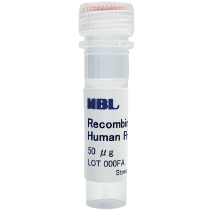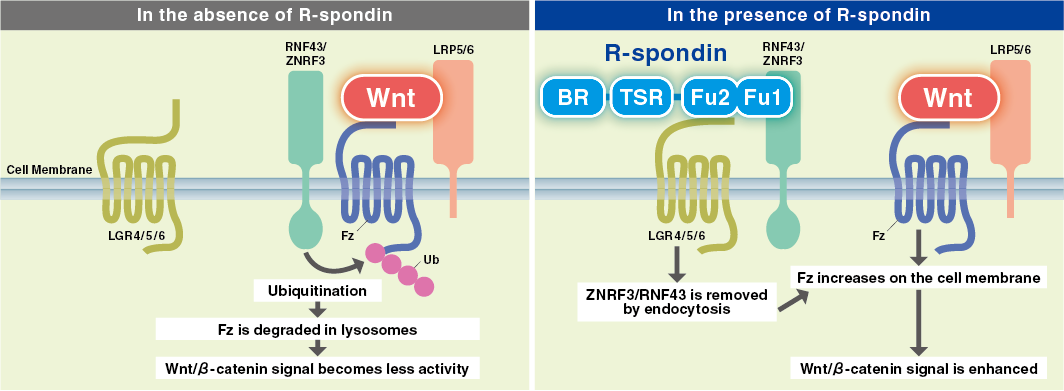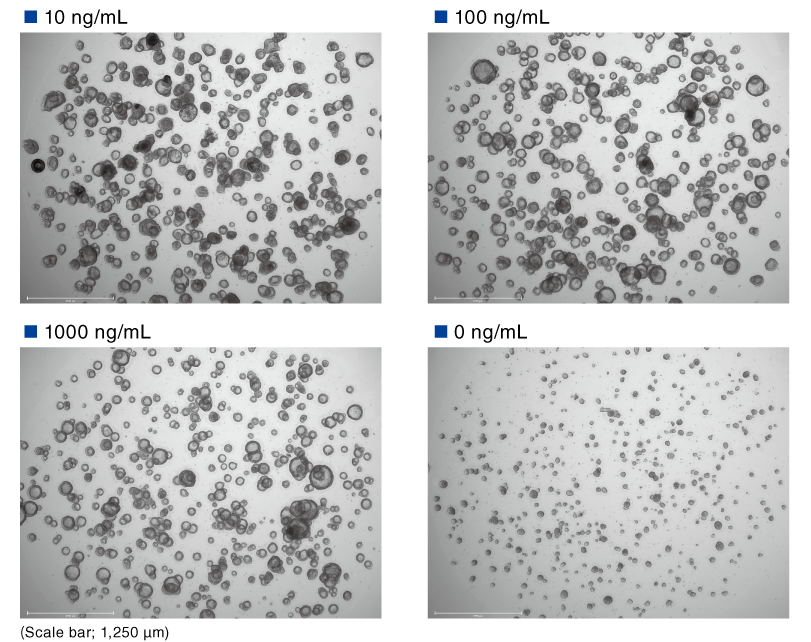- Japan(Japanese / English)
- Global
- MBL TOP
- MBL site search
Recombinant Human R-spondin 1
FEATURE

- Expression in E. coli
- Bioactive domain
- Act as a Wnt signal activator
Contents
■ What is R-spondin 1?
■ Product Usage Example
・Human intestine organoid culture
■ Product Summary
■ References
What is R-spondin 1?
R-spondin 1 (roof plate-specific spondin 1), also known as Cristin 3, is one of the R-spondin family members that regulates to the
activation of canonical Wnt/β-catenin signaling. In the canonical Wnt/β-catenin signaling pathway, when Wnt binds to cell surface receptors, Fz*1 and LRP5/6*2, intracellular β-catenin accumulates and activates the β-catenin pathway.
However,in the absence of R-spondin, Fz is endocytosed by being ubiquitinated by the binding of the ubiquitin ligase RNF43*3/ZNRF3*4, Fz on the cell membrane decreases, and Wnt/β-catenin signals are not activated enough. Conversely, in the presence of R-spondin, RNF43/ZNRF3 forms trimers with LGRs*5 and R-spondin and is endocytosed, making it unable to ubiquitinate Fz.
As a result, Fz on the cell membrane increases, and Wnt/β-catenin signals are strongly activated.1)
Organoid culture is typically utilized niche factors that act on Wnt, EGF, BMP and Notch signals that control stem cell differentiation.
Among these signals, R-spondin 1 contributes to the activation of Wnt/β-catenin signals as described above.
MBL’s Recombinant Human R-spondin 1 (Code No. J2-004) is a protein derived from the gene encoding human R-spondin 1 (region; 21-146 aa) expressed in E. coli. This region contains a bioactive fragment comprising the two cysteine-rich furin-like domains (Fu1 and Fu2). Fu1 binds to the extracellular domain of ZNRF3 and RNF43, and Fu2 binds to the extracellular domain of LGR4/5/6. 2)
*1 Frizzled, *2 low-density-lipoprotein receptor-related protein 5/6, *3 ring finger protein 43, *4 zinc and ring finger 3, *5 leucine-rich repeat-containing G-protein coupled receptors


adapted from Kikuchi, A. et al. Seikagaku. 2020
Product Usage Example
Human intestine organoid culture
Human intestine organoid culture
Human small intestine organoids were cultured in the presence of Rrecombinant Human R-spondin 1 [J2-004]. As a result, it was confirmed
that human small intestine organoids could be cultured under conditions in which MBL’s R-spondin 1 was added at a concentration of 10
to 1000 ng/mL.

Product Summary
| Code No. | Product name | Source | Accession No. | Form | Size |
|---|---|---|---|---|---|
| J2-004 | Recombinant Human R-spondin 1 |
21-146 aa | Q2MKA7 | Lyophilized from PBS | 50 µg |
References
1) Kikuchi, A. et al. Seikagaku. 2020
2) Gui-Xun, Shi. et al. Prog Biophys Mol Biol. 2016 [PMID: 27237581 ![]() ]
]
Regarding to this product, we do not offer any non-infringement warranty when used or otherwise applied in combination with other factors. Therefore, if you intend to use this product in combination with other factors, please check with your organization’s division responsible for intellectual property rights or your research agency before using this product.



